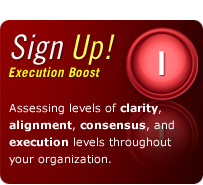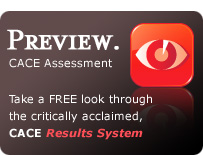Outline for Starting a Strategic Business Plan
by John Spence
July 5th, 2006
I have had a significant number of clients approach me and ask for help in putting together a “strategic” plan or at least some sort of a written plan to help them keep themselves and their staff on course. From small start-ups to divisions of multi-billion dollar corporations many either have not made the time to create the document or just don’t have a clear idea of how to put such a plan together. Although strategic planning can be extremely complex, it is also possible to build a simple, clear and compelling plan that will make a huge positive difference in the effectiveness of your operations.
Let me outline here what I believe are some of the most fundamental aspects of a plan, describe what each is component is, and offer you a chance to do some of the necessary work as you go through this article.
Vision Statement
This is a topic that has gotten a lot of attention in the past few years. Although several business “Gurus” have given the idea of vision statements a bad name, the truth is that having a clear, compelling and vivid vision of where you want to take your company is absolutely essential. I have never worked with any company that was able to achieve and sustain a high level of success that did not have a vision statement and written plan to achieve it. Never!
A few things about vision statements:
- Now it is your turn, what is your “vision” for the future of your company? You can write out a lot of things, make pages of notes, but you need to eventually get it down to one clear, simple, honest statement of what the desired future of your firm is. I have included a number of vision statement examples at the end of the article, take a look at those then spend some time crafting a vision for your organization.
- If you feel that a mission statement is relevant to your organization as well, then also take some time to work on that too. Remember the mission is all about “why’ your vision is important. Why does your company exist, who does it serve, how do you make a difference? Again, I have included some examples at the end of the article of what a mission statement looks like to act as a guide as you work on yours.
- Many companies also create a list of “Core Values.” I personally think this is a super idea. A “values statement” sets out a standard of behavior, it fosters better decision making by letting people know what is acceptable and what is not, and it builds a sense of community through a group of people committed to the same values. It critical that you give the values a great deal of thought, because once adopted they will have a profound impact on the operation of your company. These are the guiding principles that will determine a great deal of the key decision I your company. Who gets hired, who gets fired, what projects you take on, what clients you accept and what you walk away from. But perhaps even more important, the values will set out a very clear standard for how the senior leaders MUST conduct themselves at all times. As Jack Welch said, “If someone makes a mistake in their job we work hard with them to correct it and help them not make it again, but if someone violates the GE values – they are gone immediately – regardless of position or title.”
- As always, make this short, clear and straightforward. You do not need 30 values, only a handful of core guiding values that you will hold yourself and every single employee 100% accountable for living every single day. A few that come to mind are honesty, respect, integrity and service. Think this through and write a list of core values for your company, with a brief description of specifically what each value means (also see values examples at the end of the article):
- All right, you have tackled three of the most challenging aspects of building a solid and compelling plan: the vision, mission and values statements. To my mind these components focus more on motivation and culture, they are the elements that get people excited and committed and help them understand what sort behavior is expected. Next we turn our attention more toward the operational part of the plan as we look at Strategic Objectives.
- Also called Key Result Areas, Major Objectives, Strategic Thrusts and a number of other monikers, what these really boil down to are: what is the handful (4-7) of most important things for the entire company to focus on? What are the critical things that all of your people should make a priority in how they allocate time, resources, people and attention? This could be things like: customer service scores, six-sigma manufacturing, R&D, innovation, sales numbers, market share, financial goals, talent development. In truth, this is the “strategy’ of the strategic plan. This is where you decide what you are asking your people to spend the bulk of their time on, and by default, what they will not spend time on as well!
To develop a solid list of key business objectives requires 4 essential steps:
- Study
Reading books, attending seminars, benchmarking against other companies, researching your industry, keeping up with important developments in your field and with your competitors. Constantly taking in as much information as you can about your business and the markets you operate in. - Experience
Watching what works and what doesn’t inside of your organization. Testing new ideas, learning from mistakes, asking question, exploring theories. Doing everything you can to be an “expert” on your company; your systems, processes, procedures, and structure. - Insight
This is the difficult part. This taking all of your study and combining it with your personal experience and then taking a step back to look for patterns. Watching your company, your competitors, your market… all the while trying to see what other people don’t. To recognize a trend before others do. To uncover the core aspects of what it takes to be successful, profitable, to achieve your vision. At its foundation this is in large part what leadership is about. Taking the long view, seeing the future and then helping your people build a company to make that future real. This was Henry Ford seeing the power of mass production and the assembly line. This is Andy Grove from Intel seeing the demise of memory, shifting the company to processors and embracing Moore’s Law. This is Sam Walton cracking the code on how to dominate Big Box retailing. This was Ray Kroc seeing the power of fast food and drive-up service and combining it with his insights about the new national highway system and family travel. Is this easy, NO. But it is also not impossible, and actually not nearly as hard as I am making it sound. The problem is that so few leaders ever invest the time or effort necessary to even scratch the surface on this! - Execution
Put briefly, even the best idea is 100% completely useless if you do not execute it. Only companies that can take good ideas and pursue them through a strong performance oriented culture have an opportunity to succeed in the long run (we’ll talk more about this in the next section). to read about the “Execution Crisis” in Corporate America, click here
Strategic Objectives
What are your top Strategic Business Objectives? Once again: brief, clear, specific, honest and easy to understand.
After you have completed that step, the next assignment would be to take each major objective and create SMART goals for its implementation. Specific, Measurable, Agreed Upon, Realistic and Time-bound. In other words, we need to go from the strategic to the tactical. Here are some thoughts on how to develop an action plan that gives you every chance for success:
- Make sure every goal is clear, measurable and observable. It needs to be obvious to everyone if the goal has been met or not. No ambiguity.
- Every action must be assigned to one or possibly two people who will have ultimate responsibility for getting it done. There may be dozens of people involved, but there needs to be a specific individual or very small team that is 100% accountable for the outcome.
- I believe that at this stage it is critical to get the people who will be responsible for implementation to develop the actions. They are the ones that have to do the work, they have the front-live knowledge and experience and they know what will work and what won’t. You might set the goal, but let them figure out the best way to get there, let them have the ownership.
- Important question: do they have all of the time, resources, equipment, people, training and authority they need to accomplish the goal? If not, get it for them… or change the goal.
- Once you have established a set of strategic objectives and developed the necessary goals and action steps to achieve it, you must be VERY rigorous in holding people accountable for delivering on their commitments and executing their action steps… with out becoming ruthless about it. This is a fine line to walk, but if you have a clear and compelling vision and a set of shared core values, they will come to expect that everyone will be held accountable for their behavior and performance.
- When you miss a goal or things don’t work out the way you planned be disciplined in doing a postmortem. Take a close look to see where mistakes were made and then develop a plan to make sure they don’t happen again. By the way, if things work out great, that is worth a little study too. You would be surprised how few companies ever take the time necessary to look back and figure out why things went well, why things went off track. This sort of reflection and learning is invaluable.
- Lastly, when things do go well – celebrate. Let people know you appreciate them with honest praise and positive feedback. Help them to see the direct connection between accomplishing key goals – the success of the company – and their personal success.
This has been a very rough and simplistic outline, but still I believe it gives you a flavor for what a good plan should encompass and how to pull those elements together. If you have done the exercises then you should now have in front of a concise and compelling vision statement, possibly a mission statement too, a set of core corporate values and a list of your top strategic objectives. There is still a lot of work to be done getting feedback, gaining commitment and creating a detailed set of action steps, but at least you have gotten a good start.
My parting advice to you would be this: Give your plan serious time and thought.
You won’t develop this overnight. You can’t run off for a one-day retreat and expect to have a nice shiny new plan by the end of the day. This is a very important document. It sets out what you want your company to be, what you ask your people to and it drives all of the key business decisions going forward. Done poorly it can spell the demise of your organization. Done correctly it fosters strong commitment, open communication, shared values, increased motivation and gives your company a distinct and defendable advantage in the marketplace. And who wouldn’t want that!
Vision Statement Examples
Elvehjem Museum of Art
The Elvehjem Museum of Art will be a leader among university art museums. Supported by the resources of the Kohler Art Library, it will be a dynamic center for research, education and experimentation in the visual arts.
Wisconsin Division of Community Development
We will be a catalyst for joint community development efforts at the local, regional, tribal and state levels, a clearinghouse for community development information and resources and a catalyst for local capacity building; and a recognized leader in providing technical assistance.
Center for the Deaf and Hard of Hearing
The Center for the Deaf and Hard of Hearing will be the recognized statewide leader providing a continuum of dynamic and innovative programs for persons of all ages who are deaf or hard of hearing.
Vernon Hills, Inc.
We will be a proactive leader in the provision of health and senior residential services. As a respected employer of first choice, we will provide high quality, diversified services in an environment that exceeds customer expectations. Our industry leadership and financial strength will assure an atmosphere that maximizes our clients’ highest potential.
Bowling, Inc.
More people, bowling more often, having more fun.
Milwaukee Public Library
The Milwaukee Public Library is Every person’s gateway to an expanding world of information. Providing the best in library service, we guide Milwaukeeans in their pursuit of knowledge, enjoyment, and life-long learning, ultimately enriching lives and our community as a whole.
Mission Statement Examples
Wal-Mart “To give ordinary folk the chance to buy the same thing as rich people.”
Mary Kay Cosmetics “To give unlimited opportunity to women.”
3M “To solve unsolved problems innovatively”
But notice how these one-line samples are supported by value statements that show how the mission will be accomplished and measured.
- Merck “To preserve and improve human life.”
- Corporate social responsibility
- Unequivocal excellence in all aspects of the company
- Science-based innovation
- Honesty & integrity
- Profit, but profit from work that benefits humanity
- Walt Disney “To make people happy.”
- No cynicism
- Nurturing and promulgation of “wholesome American values”
- Creativity, dreams and imagination
- Fanatical attention to consistency and detail
- Preservation and control of the Disney “magic”
Article Filed under: I. WATER (Team/Group Excellence)



1 Comment Add your own
1. Carpentry in Boonville | May 2nd, 2013 at 7:08 pm
I blog often and I genuinely appreciate your content.
This article has truly peaked my interest. I’m going to take a note of your blog and keep checking for new details about once per week. I opted in for your RSS feed too.
Trackback this post | Subscribe to comments RSS Feed
Leave a Comment
Some HTML allowed:
<a href="" title=""> <abbr title=""> <acronym title=""> <b> <blockquote cite=""> <cite> <code> <del datetime=""> <em> <i> <q cite=""> <s> <strike> <strong>